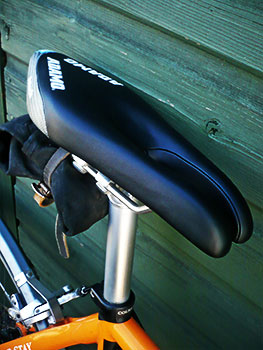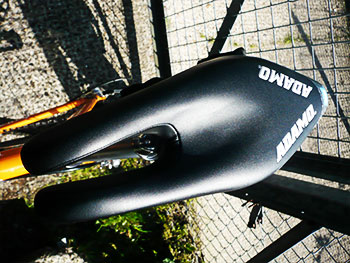
..........................................................................................................................................................................................................
are we sitting comfortably? ism adamo attack saddle

there is, generally speaking, nothing new under the sun, or at least, that is as we are led to believe. doubtless if we had unrestricted access to the drawings filed in the patents office, and sufficient free time for endless perusal, we'd discover this to be true, but there's no doubt that every now and again, along comes something that looks so outlandish as to be not only new but slightly incomprehensible.
legend has it that john boultbee brooks, inventor of the leather saddle we all know and (sometimes) love was lent a bicycle by a friend when his horse died, leaving him bereft of suitable transport. so uncomfortable was the saddle on that bicycle, that mr brooks suffered greatly in his daily transportational ministrations. certain that he could improve upon that on which he sat, he brought the brooks leather saddle to market. the rest, as they say, is history.
however, with one or two exceptions, brooks saddles, on which the majority of contemporary designs seem to be based, enter service with the comfort factor of a coal bunker. it is only through regular riding and application of 'saddle soap' that the leather upper conforms to one's own posterior imprint, that eventually one can ride hither and thither with a smile on one's face and without a care in the world.

however, even after this breaking-in period, a certain level of discomfort still has the ability to give at least minor cause for concern, just at the the most awkward of moments. though i appear to have a backside that is all but saddle agnostic, i cannot truthfully maintain that each and every bike ride resembles an afternoon sat in the comfort of a parker knoll armchair. discomfort, as i am wont to call it, seem to be at its worst when powering (all terms of effort are relative) into a perennial atlantic headwind.
this latter situation is one that is a relatively common occurrence round these here parts. it seems that, in order to defeat the drag effect encouraged by a headwind, it is incumbent upon the rider to tilt themselves forward just a smidgeon, lowering the profile presented to a wall of rushing air. doing so is not without repercussions, for one's nether regions (or 'junk' as dz nuts mentions on its packaging) are then placed in the ignominious position of harbouring greater pressure than they were originally designed for. educated conjecture would tend to suggest that the problem is not only one disagreeably felt by by the male of the species.
brooks themselves have presented patented drawings from a goodly number of years ago, that show a slot cut in the top of the saddle designed to relieve pressure on what is euphemistically referred to as soft tissue. it is a method that has been successfully/unsuccessfully applied by the majority of saddle manufacturers. indeed, i have just such a saddle that is normally resident on the colnago master, and though it fulfils at least a portion of its purpose, the nose of the saddle still has the ability to irritate by way of unrequired numbness in places where numbness is not too much fun.

the ism adamo attack saddle seeks to alleviate all perineal numbness by looking particularly weird. it almost looks like a rather aerodynamically shaped foot with two pronged toes. with the split at the front offering two distinct noses, the split widens slightly before conjoining into a more conventional shape at the rear. ism are particularly keen that the saddle be fitted to the seatpost correctly in order that the proffered benefits are suitably appreciated by the rider, and uk distributors upgrade were almost insistent that i watch the demo videos before heading out onto the open road.
i confess that my misinterpretation of the ism design figured (incorrectly), that each of the two prongs were independently suspended, thus providing some sort of pressure alleviaton of the sit-bones, but in fact, the adamo attack is quite rigid as regards its fixing. like many a road-style saddle, the padding is relatively minimal, for the saddle's stock-in-trade is the placing of that split at the front.
with each of the sit bones independently catered for, the so-called soft tissue has no need of providing any support to the rest of the body, and even on lengthy rides into gale-force headwinds (around 80km), there was no trace of numbness whatsoever. of course, removing one factor from the more regular equation does not arrive without some form of consequences, and those sit bones which would more normally have at least a modicum of assistance from that softness, are now required to take on greater responsibility.

this, however, is the equivalent of training thigh muscles to assist with ascending; a bit sore at first, but eventually not that much of a problem.
the biggest difference is that of width, particularly at the front of the saddle. many contemporary standard saddle designs offer a very narrow nose, all the easier for moving around and on and off in regular cycling activity. sitting down again after standing to climb is initially a weird sensation, though not beyond getting used to. i'd figure that perhaps the biggest obstacle to wholesale adoption of any of the ism saddle designs is the look. for while few, if any, will recognise that on which you sit during pelotonic activity, left outside the coffee shop, i can almost guarantee quizzical stares and the inevitable questions.
however, were the design purely for misplaced aesthetic reasons, defence of the realm might be a bit of a struggle. however, after several lengthy rides sat on the attack, i'd be happy to defend my choice to anyone who happened to ask. it may look completely wrong, but that's probably john boultbee brooks' fault in the first place. this is saddle comfort of a magnitude you will have rarely experienced.
sometimes weird is good.
the ism adamo attack saddle is distributed in the uk by upgrade bikes. retail cost is around £175
wednesday 1st may 2013
